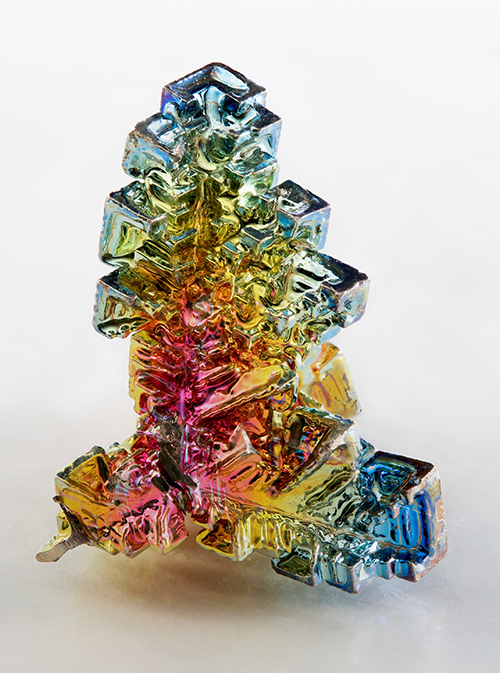
By Steve Voynick
Among the most eye-catching items displayed at gem and mineral shows and rock shops are those familiar clusters of metallic “hopper” crystals that gleam like iridescent rainbows. These wildly colorful, synthetic crystals are bismuth and the only elemental bismuth that most of us ever see.
Bismuth is a brittle, silver-white metal with a hint of pink and sometimes a multicolored tarnish. Its physical properties are somewhat similar to those of lead, although bismuth is more rigid and much less abundant. And bismuth’s melting point of 520 degrees F. (271 degrees C.) is substantially lower than that of lead.
Bismuth’s large atom has a correspondingly high atomic weight of 208.9, higher even than gold and platinum. Atomic weight is a relative measure of atomic mass and does not indicate density. Bismuth’s loose atomic packing gives it a density (specific gravity 9.8) less than that of lead (specific gravity 11.3). Also, it weakens its metallic bonding, which explains its softness and low melting temperature.
Believing it to be “unripened silver,” medieval alchemists knew bismuth as tectum argenti (“silver being made”). Bismuth was confused with lead and tin until 1546 when German scholar Georgius Agricola suggested a different metal. But it wasn’t until 1753 that French chemist Claude Françoise Geoffroy conclusively proved that bismuth is a distinct element. Bismuth’s name stems from the German Wismut, or “white mass,” likely alluding to its white oxide.
Although occasionally occurring as a native metal, bismuth is most abundant as the trisulfide bismuthinite (Bi2S3), which is often associated with the sulfide ores of lead, cobalt, zinc, and silver. Other important bismuth-bearing minerals are bismutite (bismuth oxycarbonate, BiO2CO3) and bismite (bismuth oxide, Bi2O3).
About 19,000 metric tons of bismuth are recovered worldwide annually, almost all as a by-product of lead and silver smelting. China accounts for 85 percent of the world’s production. With the demise of lead smelting in the United States, the nation depends on foreign sources for its entire bismuth supply.
The industrial price for refined metallic bismuth is now about $5 per pound.
Bismuth’s uses are keyed to its unusual properties. Many bismuth alloys have extremely low melting points, some even lower than the boiling point of water. Most metallic bismuth is used to manufacture heatliable plugs in automatic, sprinkler-type fire-suppression systems.
Bismuth is extremely diamagnetic and repels magnetism. And unlike other metals, its electrical resistance increases in magnetic fields, making it useful in magnetometers and other instruments that measure magnetic intensity.
Bismuth expands upon solidifying, a property shared by only two other common materials—water and antimony. Bismuth casting and soldering alloys, respectively, can thus fill the finest details of a mold and completely seal soldered joints. And because it is nontoxic, bismuth substitutes for lead in shotgun pellets, fishing sinkers, ceramic glazes, crystal glass, and plumbing solders.
For centuries, bismuth compounds also have served as remedies for stomach ailments. The “Bis” in Pepto-Bismol® stems from its active ingredient—bismuth subsalicylate, an antimicrobial and anti-inflammatory agent, and an antacid. Kaopectate® and similar over-the-counter remedies also contain bismuth subsalicylate.
Despite its unusual properties and uses, bismuth remains best known for those iridescent, synthetic crystals with their rainbow-like colors. These are created by cooling molten bismuth slowly so that it crystallizes into clusters of cubes with outward-extending edges and repetitive, inner “stair-steps” descending to concave centers—the classic “hopper” configuration. Because bismuth crystallizes in the trigonal system, these cube-shaped crystals are actually a pseudocubic habit.
As it solidifies, bismuth reacts with atmospheric oxygen to form microscopically thin surface films of bismuth oxide. The bright, iridescent cyan, green, gold, and magenta colors that light up those hopper crystals are not related to metallic bismuth but are caused instead by how light interacts with and reflects from thin surface films of bismuth oxide.
If you enjoyed what you’ve read here we invite you to consider signing up for the FREE Rock & Gem weekly newsletter. Learn more>>>
In addition, we invite you to consider subscribing to Rock & Gem magazine. The cost for a one-year U.S. subscription (12 issues) is $29.95. Learn more >>>
















